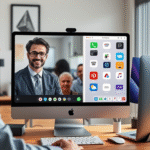USB-C Transition is reshaping the way iPhone users interact with their devices as Apple moves away from the Lightning connector to adopt a universal charging standard.
This article will explore the implications of this significant change, including the need for new accessories, the environmental benefits associated with reduced e-waste, and the role of regulatory pressure from the EU.
By understanding the shift towards USB-C, users can better prepare for the adjustments needed to maintain compatibility with their existing devices and accessories moving forward.
From Lightning Origins to USB-C Momentum
Introduced in 2012, Apple’s proprietary Lightning era began as a sleek alternative to the aging 30-pin dock, offering faster data transfers and a reversible design that simplified daily use.
With widespread adoption across iPhones, iPads, and accessories, Lightning became synonymous with Apple’s ecosystem.
However, as the broader tech industry moved toward USB-C—finalized in 2014—Apple’s reluctance to shift sparked notable frustration, especially as competitors like Samsung and Google streamlined device charging through universal USB-C solutions.
The turning point came as EU regulations mandated a common charging port, making the iPhone 15 the first to adopt this standard-setting shift across all new models.
The implications for users extend far beyond cable swapping.
Embracing USB-C allows for seamless compatibility across devices, from laptops to earbuds.
Power delivery increases considerably, and users benefit from enhanced data transfer speeds.
This transition supports a universal approach to charging and syncing, streamlining tech experiences.
However, legacy accessories will now require adapters or upgrades—an irritation for those heavily invested in Lightning-based gear.
The update is especially significant when using new MagSafe accessories, as they require at least a 20W adapter for peak performance.
- Enhanced device compatibility across brands
- Reduction of charger-related e-waste
- More efficient charging and data transfer speeds
Selecting Quality USB-C Chargers and Cables
When choosing USB-C chargers and cables for Apple devices, always check for official certification logos like the MFi (Made for iPhone) badge.
This symbol ensures the accessory has passed Apple’s quality standards and works seamlessly with their products.
Trusted brands such as Anker and Ugreen typically include MFi logos on packaging or product descriptions.
Additionally, high-quality cables often feature durable woven exteriors and clear labeling of charging capacity and data transfer rates, which are essential for performance and safety.
Smart buying habits start with purchasing only from reputable retailers or authorized stores.
Be cautious with ultra-cheap options found online or in local grocery shops, as they may be counterfeit products that look genuine but fail to protect your device.
For optimal performance, Apple recommends using at least a 20W USB-C power adapter when pairing it with their MagSafe charger.
Investing in certified and quality-tested accessories minimizes risk of overheating, short-circuiting, or slow charging times.
Adapting Audio and Peripheral Gear
To ensure seamless transition for your existing gear, adapting headphones, microphones, and other peripherals to the new USB-C standard is essential.
One common solution is the Apple USB-C to Lightning Adapter, which supports charging, data transfer, and audio with older Lightning accessories.
For audio devices that rely on a headphone jack, using a USB-C to 3.5 mm adapter offers immediate compatibility without sacrificing sound quality.
Some professional gear, such as external microphones, can also be connected directly via a USB-C interface, which can provide both power delivery and faster data speeds.
As USB-C becomes more universal, these adapters and accessories ensure your existing audio and peripheral devices remain functional without needing complete replacement, saving both time and money while enhancing future compatibility across devices.
Environmental and User Benefits
Apple’s shift to USB-C brings significant advantages for users and the planet, primarily through reduced e-waste.
By embracing this universal standard, Apple aligns with EU regulations and actively supports global environmental goals.
According to insights from Apple’s sustainability actions, using one type of cable across multiple devices drastically minimizes the volume of electronic waste and conserves precious resources.
Instead of producing separate Lightning cables, Apple can streamline production, lowering emissions from materials, packaging, and shipping.
Even though this change may lead to a short-term rise in discarded Lightning accessories, the long-term benefits far outweigh the initial impact, as fewer cables and adapters will be needed moving forward.
Beyond eco-impact, USB-C enhances cross-device compatibility, letting users charge an iPhone, MacBook, or iPad with the same connector.
This efficiency not only declutters households but significantly simplifies travel and device maintenance.
As noted in reports on user and environmental advantages, this transition empowers consumers with freedom of choice and connectivity.
Additionally, with support for fast charging and improved data transfer, performance becomes a practical advantage.
Apple’s ecosystem now reflects a commitment to unified, user-friendly charging, reducing friction in daily tech use.
- Streamlined charging through universal compatibility
- Less electronic clutter and waste over time
- Improved travel ease with fewer cables and chargers
MagSafe Meets USB-C Charging
Apple’s shift to USB-C charging harmonizes seamlessly with its continued use of MagSafe technology.
While newer iPhones now feature a USB-C port at their core, accessories like the MagSafe Charger still play a central role by offering magnetic alignment and optimized wireless performance.
Despite the transition to USB-C, the MagSafe puck still snaps magnetically onto the back of compatible iPhones, maintaining its unique user-friendly charging experience.
However, to benefit from optimal charging speed, users must pair MagSafe with at least a 20W USB-C power adapter.
Without adequate wattage, delivery performance drops drastically, negating the fast-charging capabilities MagSafe is designed to deliver.
This interaction between MagSafe and USB-C emphasizes wireless efficiency without sacrificing convenience.
USB-C allows for broader charger compatibility across Apple’s product ecosystem, but users should remain mindful that older Lightning-based power bricks no longer suffice.
Furthermore, MagSafe still relies on Qi and Qi2 standards, ensuring it wirelessly charges not only iPhones but also compatible AirPods models, as confirmed on the official Apple page for MagSafe chargers.
This creates a streamlined experience for those transitioning from Lightning to USB-C, preserving familiar features under a more universal charging framework.
The blend of universality and magnetic simplicity enhances overall compatibility without compromising performance or user expectations
Regulatory Impact Overview
The European Union played a decisive role in transforming Apple’s long-held stance on proprietary ports by enforcing the EU Common Charger Directive.
This legislation mandates phone manufacturers to adopt USB-C by 2024 to streamline connectivity and reduce e-waste.
Such pressure left Apple with no practical alternative but to pivot away from its exclusive Lightning connector.
By harmonizing charging standards across devices, the EU aims to protect consumers and the environment alike.
While Apple resisted for years, EU regulations forcing USB-C adoption made the shift inevitable.
| Regulation | Goal | Effect |
|---|---|---|
| EU Common Charger Directive | Reduce electronic waste | Apple replaces Lightning with USB-C |
| Unified Charging Standard Mandate | Improve user/device compatibility | iPhones align with global USB-C ecosystem |
| EU Digital Sustainability Goals | Promote long-term environmental policies | Push for common hardware across devices |
Globally, Apple’s compliance with European directives signals a broader shift in technology policy.
As one of the most influential device makers adjusts to supranational regulation, markets outside the EU benefit from improved interoperability and less cable clutter.
Consumers worldwide now gain more flexibility, making accessories like charging pads and cables more universally functional.
The regulatory push also pressures other countries to follow Europe’s lead, potentially establishing USB-C as the gold standard in mobile charging.
Apple’s move underlines how powerful legislation can redefine user experience beyond national borders.
In conclusion, the transition to USB-C represents a pivotal change for iPhone users, enhancing compatibility while promoting sustainability.
As users adapt to this new standard, the benefits of a universal charging solution will become increasingly apparent.




